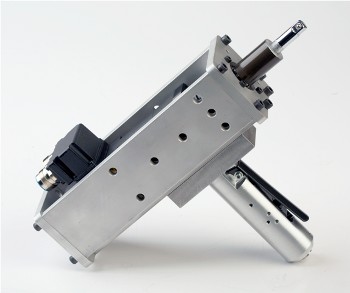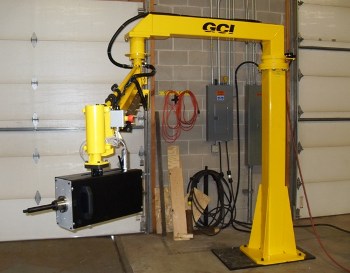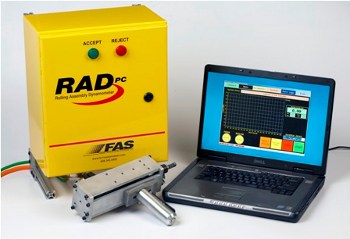 |
| March 13, 2012 | Volume 08 Issue 10 |
Designfax weekly eMagazine
Archives
Partners
Manufacturing Center
Product Spotlight
Modern Applications News
Metalworking Ideas For
Today's Job Shops
Tooling and Production
Strategies for large
metalworking plants
Engineer's Toolbox:
Customized torque-gun system gets optimized with configurable components
Innovative "rolling-resistance" measurement device and smart PC-based software provide users with accurate and consistent torque optimization of geared assemblies such as transmissions, gear boxes, and pumps.
Farris Automated Systems has long been a leader in the design and manufacture of innovative assemblies for installation in automated industrial machinery and equipment. The Hartland, WI-based firm's customized turnkey systems include pick/place/sort machinery, fastening systems, quality control testing, and visual inspection systems for automotive and industrial OEMs, as well as automatic filling and labeling stations for food and medical processors.

Farris Automation's RAD System gun frames can use up to 16 different motor and gearbox combinations, depending on each user's application requirements. With Misumi's configurable mechanical components and short lead times, Farris does not have to maintain an extensive array of stocked parts, but can order them as needed.
Like any industrial company, Farris is always looking for ways to control costs while maximizing production speed and delivery cycles. Let's take a look at one way in which Farris Automated Systems achieves these goals in producing one of its first-to-market innovations: the Rolling Assembly Dynamometer (RAD) System.
During the RAD System design phase, one of the challenges was to configure the system's main hardware component a torque measurement gun to varying application specifications of a diverse customer base. In searching for solutions, Farris engineers tapped into the value of specifying configurable components that would allow faster customization and timely deliveries without the need for maintaining large and expensive parts inventories.
Designing the RAD System
Farris's RAD System was designed to provide a practical, easy-to-use solution for clearly defining the specification of how a "smooth" spinning assembly should perform. Before its launch, this definition was typically left to an operator using a torque wrench to manually turn the assembly and "guess-timate" its smoothness value. This was an error-prone process that could lead to performance and warranty problems stemming from operator inconsistencies or inexperience.
The RAD System eliminates all inconsistency by accurately measuring the torque required to spin a geared assembly such as a transmission, differential, gearbox, axle or pump and enabling the user to optimize the ratio of torque to load. In recording a series of torque signatures, which takes about 30 sec, the tool can determine if the final product was assembled correctly. According to Brian Terry, Farris Automated Systems mechanical engineer, "The RAD System was the first tool of its kind to be able to optimize torque on the fly with precise accuracy and virtually no rejects. And the RAD System is consistent and repeatable it will give the same result from operator to operator."

The RAD System shown here has been adapted for a factory automation application. Other enclosure options are also available, including a pit-cart-mounted unit designed for racing teams or large shops needing flexibility to move the RAD System to wherever it is needed.
"The most common use for the tool is enabling the operator to set the proper bearing preload," says Terry. "If the assembly turns with too little torque, the bearings will chatter and wear more quickly. If it turns with too much torque, the bearings will not roll properly and can steal horsepower from the engine. What you want to achieve is an optimized value that enables smooth spinning of the assembly."
In action, the RAD System uses a gun assembly, motor controller, and PC/software combination to rotate the input shaft of an assembly. While it's rotating, the software allows the operator to gauge performance and reports back whether the assembly is performing properly.
Some common RAD System applications include:
- Measuring rolling resistance and testing bearing preload;
- Testing for proper gear mesh, including detecting hidden wear in gears or bad gear teeth;
- Checking for any significant change in pump rolling resistance to ensure against pump failure or worn pump rotor; and
- Performing R&D testing to quantify design or component changes. For example, you can test the design efficiency of higher-priced, low-friction gears versus standard gears to determine if the component upgrade is worth the price differential.
RAD software, available in four different versions, provides the "brains" of the system. On the hardware side, rolling-resistance gun options include a handheld unit for torques under 20 NM, vertical and horizontal mount units for torques over 20 NM, and torque tube-mount versions for high-torque, high-production-volume applications. Enclosure options are also available, including a pit-cart-mounted unit designed for racing teams or large shops needing flexibility to move the RAD System to wherever it is needed.
Configurable components enable faster delivery times
In searching for a viable way to customize and configure the RAD rolling-resistance gun to each user's unique needs without having to maintain large parts inventories, Farris turned to Misumi USA, a leading supplier of configured mechanical components for machine building, motion control, and factory automation systems.

Farris Automation's RAD System is comprised of the rolling-resistance torque gun and motor controllers. A PC and software combination provide the "brains" of the system.
Terry explains why this issue was such a challenge. "The gun frame can use up to 16 different motor and gearbox combinations. In order to deliver within the promised timeframe, we need to be able to quickly configure different lengths of hex standoffs and flange bearings. Misumi offered these parts at competitive prices and with extremely short lead times with no minimum order requirements. So we can assemble the guns to spec pretty quickly without having to stock all the variable combinations."
Terry notes that Farris uses Misumi's fixed and configurable parts in a variety of the company's automation systems. "Being able to select and configure mechanical components to our precise specifications is a huge benefit," he says. "We also rely on Misumi's online system to download accurate 3D CAD drawings directly into our SolidWorks program, and we routinely use their Web Ordering System to order the parts. Overall, this translates into significant time and cost savings for our engineering team."
The RAD System is a winner for customers of Farris Automated Systems, as well. Since its launch, the innovative rolling-resistance solution has found enthusiastic acceptance across the industrial marketplace.
"Customers tell us that the system has settled once and for all the internal argument of exactly what constitutes smooth' performance," says Terry. In fact, one of our global customers has standardized on RAD for any rolling drag application. In addition, we have built automated equipment around this technology to increase their production rates by 300%. Other customers have begun to see its advantages and are looking at standardizing on the system as well."
Want more information? Click below.
Source: Misumi
Published March 2012
Rate this article
View our terms of use and privacy policy
